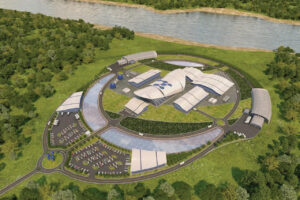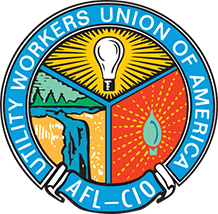The United States is working toward climate goals that include cutting greenhouse gas emissions in half by 2030 and achieving 100% carbon pollution-free electricity by 2035. These objectives have increased the urgency of developing clean and renewable energy sources.
In the race to build the ideal energy mix, small modular nuclear reactors (SMRs) are emerging as a potential solution to several complex problems. Although they have not received much mainstream attention, SMRs have been in development for decades, and their potential to be situated at existing coal-fired power plants is generating special excitement.

Many coal-fired plants could be converted into SMRs, turning them into dependable sources of clean energy, retaining most of the existing workforce and repurposing site infrastructure to lower construction and operating costs. The Biden administration has implemented significant tax credits and new funding to advance SMR projects.
The UWUA is staying abreast of developments with SMRs because they may be able to fill a gap in the energy mix that other renewables cannot address, provide a dependable source of emissions-free power, and preserve employment at potentially higher pay for UWUA members.
What are SMRs?
Small modular reactors are an advanced class of nuclear reactors that are less expensive, safer, more flexible and more space efficient than traditional reactors. SMRs are built in modules in a factory then shipped to a site where they are installed and become operating nuclear plants. Adding more modules/reactors increases generating capacity.
There are about 80 SMR designs in development in 19 countries as of 2023, and SMR units are already producing power in China and Russia. In January, the U.S. Nuclear Regulatory Commission certified the first U.S. SMR design, and the first module using this design is expected to be operational in Idaho in 2029.
Advantages of SMRs
SMRs have generating capacity of up to 300 megawatts of electricity per unit — about a third of that of traditional nuclear power plants. But an SMR’s output can be adjusted to fit the needs and transmission capacity of each situation, an advantage over a traditional reactor’s fixed capacity.
SMRs are faster to build and require less land than traditional nuclear plants and other clean sources of power. Britain’s Rolls-Royce SMR needs 10,000 times less land than a wind project and 1,000 times less than a solar project of similar capacity, power analyst Robert Bryce has written.
This means SMRs can be located on sites where large nuclear plants would not fit, and adopting SMRs would enable the United States to conserve green space and reduce the footprint of power generation.
Lastly, enhanced safety is an important attraction of SMRs. Their designs incorporate passive safety systems, and the reactors operate with low power and pressure. SMRs do not need human intervention or external power to shut down since they rely on physical forces such as gravity and convection for these safety back-ups. The International Atomic Energy Agency says these characteristics eliminate or significantly reduce the potential for dangerous releases of radioactivity.
Coal to nuclear transition?
SMRs are becoming an especially promising replacement for coal-fired power plants, which are under threat due to carbon emission regulations.
The Energy Information Administration (EIA) found that about a quarter of U.S. coal-fired power plants are due to retire by 2029. Domestic coal-fired electricity production is expected to decline about 93% by 2040 on the way to achieving net-zero emissions by 2050.
The impact of this evolution on workers has been painful. The workforce at coal power plants shrank 12% between 2019 and 2021 alone, according to the EIA, and the retirement of more facilities will add to the job loss.
But SMRs could potentially repower about 80% of coal plants studied by the DOE, turning them into emission-free power producers. Only 22% were adaptable to traditional nuclear plants.
At the same time, SMRs could help solve one of the critical challenges of current climate change goals. Power generation currently contributes about 30% of global CO2 emissions, and global power consumption could triple by 2050, according to research by McKinsey.
This demands more electricity from clean sources such as nuclear, which currently accounts for only about 10% of global electricity generation. Almost no new nuclear capacity has been added in the United States in the past 35 years for various reasons that range from changing regulatory requirements to a track record of schedule and cost overruns.
SMR technology can address many of these challenges because it reduces construction time and upfront costs, offers lower operating costs, and incorporates simplified systems that improve reliability and safety.
How would coal to nuclear shift work?
A March study by the Bipartisan Policy Center concluded that SMRs could help achieve climate goals, maintain grid reliability, respond to fluctuating power demand and preserve or improve many coal plant jobs, finding:
- SMRs can reuse coal plant transmission infrastructure, electrical equipment and steam-cycle components. This avoids some permitting obstacles and reduces construction costs by 17% to 35%.
- About three-quarters of coal plant jobs are transferable to nuclear plants with no new licensing requirements.
- In regions where SMRs replace retiring coal plants, a net job gain is likely.
- Jobs at nuclear plants pay higher wages compared to coal plants. This would be good for plant workers and boost tax revenue for local governments.
The report found that several roles at coal power plants can transfer to SMRs, including mechanics, maintenance, electricians and security with no licensing or experience requirements. Higher wages for nuclear plant jobs and a tight labor market for nuclear workers make a transition attractive.
The way forward
There are other challenges for the coal to SMR transition including technology hurdles (like how to handle disposal of nuclear waste), work needed to achieve economies of scale and potential opposition from community organizations. Timing the retirement of a coal plant and its startup as a nuclear facility can be tricky, and licensing requirements may also complicate the transition.
But the prospect of greater employment security and higher wages will continue to focus UWUA’s attention on this emerging area.

